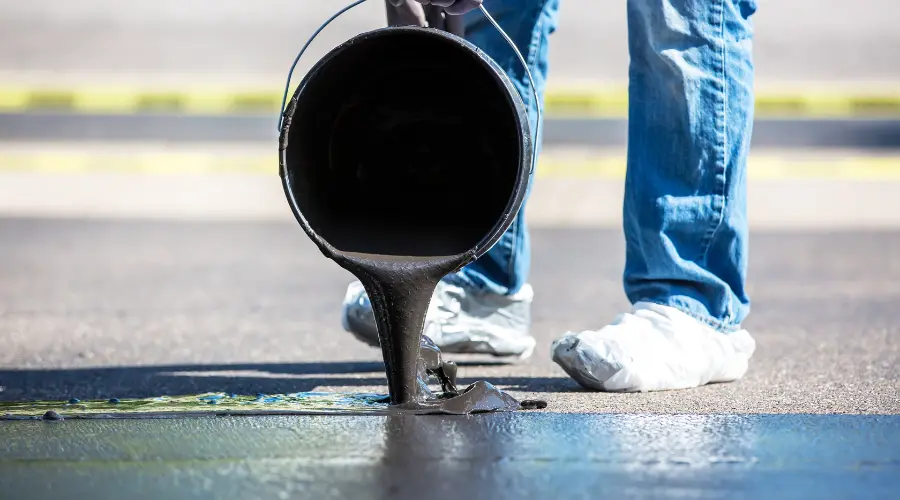Seal coating is the ultimate solution to protecting and prolonging the lifespan of your asphalt surface. This process safeguards against wear, weather damage, and aging, ensuring a polished, durable finish for years to come.
Key Takeaways
- What is Seal Coating? A protective layer that shields asphalt surfaces from water, UV rays, oil, and chemicals, enhancing longevity and aesthetics.
- Benefits of Seal Coating: Prevents cracking, improves appearance, reduces maintenance costs, and extends the asphalt’s lifespan.
- 5-Step Process: Surface preparation, crack sealing, application, curing, and post-application maintenance.
- Maintenance Tip: Reapply seal coating every 2-3 years to keep your asphalt in top condition.
- DIY vs. Professional Services: Professionals ensure precision and lasting results, especially for large or high-traffic areas.
What Is Seal Coating?
Seal coating is the process of applying a protective layer to asphalt surfaces to prevent damage from external factors like water, UV rays, oil, and chemicals. It not only enhances the durability of your asphalt but also restores its dark, rich color, giving it a “like-new” appearance. This cost-effective maintenance step significantly reduces the likelihood of cracks, potholes, and extensive repairs.
Benefits of Seal Coating
- Protection Against Damage: Acts as a barrier, shielding asphalt from harmful elements such as water, oil spills, and sun exposure.
- Enhanced Aesthetics: Restores the deep black finish of your asphalt, improving curb appeal.
- Cost Efficiency: Prevents costly repairs by maintaining the structural integrity of the surface.
- Increased Lifespan: Helps asphalt surfaces last longer, making it a valuable investment.
- Improved Safety: Reduces the risk of loose gravel, cracks, and potholes that could pose safety hazards.
The Seal Coating Process
Seal coating involves several meticulous steps to ensure optimal results. Let’s break it down into a straightforward, five-step process:
1. Surface Preparation
Proper preparation sets the foundation for a durable and effective seal coat:
- Cleaning: Remove dirt, debris, and vegetation using brooms, blowers, or pressure washers.
- Power Washing: For stubborn grime, employ a power washer for a deeper clean.
- Oil Spot Treatment: Apply a primer to oil spots for better sealant adhesion.
- Drying: Ensure the surface is completely dry before proceeding.
2. Crack Sealing
Sealing cracks prevents water infiltration and prolongs the asphalt’s life:
- Inspection: Identify and evaluate all cracks and potholes.
- Cleaning Cracks: Clear debris using high-pressure air or a crack cleaning machine.
- Filling Cracks: Apply hot or cold rubberized crack filler to seal gaps and level the surface.
3. Application Methods
Choose the best application method based on the project size and condition:
- Spray Application: Ideal for large areas, offering quick and uniform coverage.
- Squeegee Application: Provides a thicker coating, suitable for surfaces with minor imperfections.
- Brush Application: Allows for precise work on edges and intricate areas.
4. Curing
Curing is essential for the seal coat to set properly:
- Drying Time: Allow 24-48 hours for complete curing, depending on weather conditions.
- Traffic Restriction: Block off the area during curing to avoid surface damage.
5. Post-Application Maintenance
Ensure your seal-coated surface remains in excellent condition:
- Regular Cleaning: Sweep and wash the surface regularly to prevent staining and debris buildup.
- Periodic Inspections: Check for new cracks or damage and address them promptly.
- Reapplication: Apply a fresh seal coat every 2-3 years to maintain protection.
DIY vs. Professional Seal Coating
While DIY seal coating is an option for small residential projects, hiring a professional offers several advantages:
- Precision and Quality: Professionals use advanced equipment and techniques for a flawless finish.
- Time-Saving: Large projects require less time when handled by experts.
- Longevity: Professional applications tend to last longer, providing better value for your investment.
FAQs About Seal Coating
Q: How often should I seal coat my asphalt surface?
A: It is recommended to reapply seal coating every 2-3 years, depending on traffic levels and weather conditions.
Q: Can seal coating fix existing cracks or potholes?
A: Seal coating can prevent cracks from worsening, but existing cracks and potholes should be repaired before applying the sealant.
Q: How long does seal coating take to cure?
A: The curing process typically takes 24-48 hours. During this time, avoid walking or driving on the surface.
Q: Is seal coating weather-dependent?
A: Yes, seal coating requires dry conditions and temperatures above 50°F for optimal results.
Q: Can I seal coat a newly paved asphalt surface?
A: No, newly paved surfaces need 6-12 months to cure before seal coating can be applied.
Q: How do I know if my asphalt needs seal coating?
A: Signs include fading color, visible cracks, and surface wear. Regular inspections can help determine the need for seal coating.
Q: Does seal coating make asphalt slippery?
A: No, seal coating provides a smooth but non-slippery surface when applied correctly.
Q: What is the difference between seal coating and resurfacing?
A: Seal coating is a protective maintenance layer, while resurfacing involves adding a new layer of asphalt to restore structural integrity.
Conclusion
Seal coating is an essential step in maintaining and protecting your asphalt surfaces. By following a meticulous five-step process—surface preparation, crack sealing, application, curing, and post-application maintenance—you can extend your asphalt’s lifespan and enhance its appearance. For best results, consider professional seal coating services, especially for large or high-traffic areas.
Need Expert Assistance?
For top-tier paving services in Hackensack, New Jersey, Paving Hackensack is your trusted partner. Contact our friendly team today to schedule your seal coating project and keep your asphalt in pristine condition for years to come!







